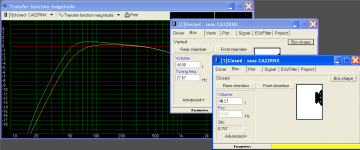I have another question for you Salas, if you don't mind. In an 8" two-way like yours, low pass crossing could be conceivably be approached another way. If the woofer behaves well enough at breakup (the Seas probably does because it's made out of damped paper rather than an alloy) one could try to make do with just one big coil in series with it. Say a 10 mH coil that crosses at a nominal 300 or 400 Hz. The idea being that the gentle attenuation early on plays the baffle step compensation part and, when frequency approaches the tweeter high pass region, attenuation is well under way even with it being at 6 dB/octave. Obviously one has to fine tune baffle width, watch woofer breakup carefully, and tweak coil inductance since it has to deal with the rising inductance of the woofer voice coil as frequency goes up. Do you think that such an approach has merit and have you looked into it?
PCT-300 wave guide
Just arrived in this post via the search engine and the word wave guide
Anyone know this driver and wave guide ?
PCT-300 - DiscoPRO - un magazin Poweraudio Romania
Thinking for a replacement for the couple TW034 Jensen wave guide
Just arrived in this post via the search engine and the word wave guide
for a good 2-way all you need is a waveguide (Monacor waveguide or similar, Dayton 8" which is bigger, or P-Audio PCT-300
Anyone know this driver and wave guide ?
PCT-300 - DiscoPRO - un magazin Poweraudio Romania
Thinking for a replacement for the couple TW034 Jensen wave guide
It is a monacor DT300 tweeter and a WG300 wave guide.Just arrived in this post via the search engine and the word wave guide
Anyone know this driver and wave guide ?
PCT-300 - DiscoPRO - un magazin Poweraudio Romania
Thinking for a replacement for the couple TW034 Jensen wave guide
http://www.troelsgravesen.dk/7100-waveguide.htm
DT300 is very nice I used it in my fatboy project.Thanks for the answer Helmuth but regarding the datasheet, PCT-300 and DT-300 daesn't seem to be the same product, respectively fs 1489 Hz and fs 750 Hz. See attachment PDF for PCT-300 on the web page.
see measurements of this site in finland.
Wave guides & horns
Last edited:
I have a tip for nice 8" driver seas. CA22RNX closed or bassreflex port on backside. So when you close the port you will have a very nice closed box, and if you want heavy bass open the port. Vent 2cm high 22 wide 32cm long.Thank for the link, I'm looking at both of them, same price range !
I'm planning to build big monitor with a 8" and a 1.25" dome + wave guide in a 35/40l bass reflex enclosure.
To close and open the port use a pice of foam like that of a cushion of a seat, thats enough to make a closed box from a bassreflex.
French shop
H1288-08 CA22RNX
Attachments
Last edited:
An outstanding set of measurements, with a single omission: they do not convey driver sensitivity, with or without a waveguide.see measurements of this site in finland.
Wave guides & horns
CA22RNX or CA22RNY that is the first question !
The second question is Monacor DT-300 + WG or P Audio PCT-300 + WG or Audax TW034 + WG . Concerning the last option, FIY the WG is quoted 125 € for two items
They are all usable to me. Will make a nice sharp priced loudspeaker.
''Frequency response of all drivers on wide curved baffle without crossover'' graph shows the RNX is good for 3 way designs only considering the green line upper midrange strong breakups.
Third order xo 1.5kHz 2 way
With third order the breakup is suppressed -18db at 3kHz I do not think this breakup will give a major difference in the response.4th order even safer maybe.
Unfortunately that mount at 4kHz the especially big one, and the other mounts, denote mechanical energy storage that takes very little triggering to be excited. In reality it will never be as good as a resonance free driver in its band pass region even when cut fast & well before. We may achieve good attenuation of anomalies for nice filter lines & phase tracking but the mechanical issue will be there ringing when rest of bandwidth energy will be dead. Can be excited not only from its own filtered signal but from the total power that the loudspeaker radiates. The KEF B139 was notorious for its 1.5kHz nuisance although always used and filtered as a low band real woofer for instance. These things are to be tested in practice by listening to candidate drivers with pink noise and a well known human voice, exchanging possible filters also, and then narrowing down to which one provides more, i.e. the gain in sensitivity of a rougher driver is what prevails and makes the speaker tick but its mechanical issues are not that apparent? Or they still stick out? Maybe a tamer in break up less dynamic driver wins for definition, lowers fatigue, dialogue diction gets easier to follow? Etc. etc.
- Status
- This old topic is closed. If you want to reopen this topic, contact a moderator using the "Report Post" button.
- Home
- Loudspeakers
- Multi-Way
- The secret of building a good 2-way
